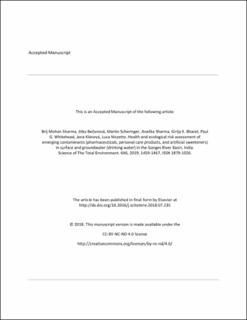| dc.contributor.author | Sharma, Brij Mohan | |
| dc.contributor.author | Bečanová, Jitka | |
| dc.contributor.author | Scheringer, Martin | |
| dc.contributor.author | Sharma, Anežka | |
| dc.contributor.author | Bharat, Girija K | |
| dc.contributor.author | Whitehead, Paul G | |
| dc.contributor.author | Klanova, Jana | |
| dc.contributor.author | Nizzetto, Luca | |
| dc.date.accessioned | 2020-06-29T08:40:13Z | |
| dc.date.available | 2020-06-29T08:40:13Z | |
| dc.date.created | 2019-06-13T13:14:01Z | |
| dc.date.issued | 2019 | |
| dc.identifier.citation | Science of the Total Environment. 2019, 646, 1459-1467. | en_US |
| dc.identifier.issn | 0048-9697 | |
| dc.identifier.uri | https://hdl.handle.net/11250/2659803 | |
| dc.description | Embargo until 01 January 2021 | en_US |
| dc.description.abstract | Pharmaceuticals, personal care products (PPCPs), and artificial sweeteners (ASWs) are contaminants of emerging concern commonly found in the aquatic environments. In India, studies reporting environmental occurrence of these contaminants are scarce. In this study, we investigated the occurrence and distribution of 15 PPCPs and five ASWs in the river and groundwater (used untreated as drinking water) at several sites along the Ganges River. Based on the measured groundwater concentrations, we estimated the life-long human health risk from exposure to PPCPs through drinking. In addition, we estimated the risk of exposure to PPCPs and ASWs in the river water for aquatic organisms. The sum of detected PPCPs in the river water ranged between 54.7-826 ng/L, with higher concentrations in the severely anthropogenically influenced middle and lower reaches of the Ganges. The highest concentration among the PPCPs in the river water was of caffeine (743 ng/L). The sum of detected ASWs in river water ranged between 0.2–102 ng/L. Similar to PPCPs, the sum of ASWs in the river water was higher in the middle and lower reaches of the Ganges. In groundwater, the sum of detected PPCPs ranged between 34–293 ng/L, whereas of ASWs ranged between 0.5-25 ng/L. Negligible risk for humans was estimated from PPCPs in the drinking groundwater sources along the Ganges River, whereas moderate risks to PPCPs and ASWs (namely: caffeine, sulfamethoxazole, triclocarban, triclosan, and sucralose) were estimated for aquatic organisms in the Ganges River. | en_US |
| dc.language.iso | eng | en_US |
| dc.publisher | Elsevier | en_US |
| dc.rights | Attribution-NonCommercial-NoDerivatives 4.0 Internasjonal | * |
| dc.rights.uri | http://creativecommons.org/licenses/by-nc-nd/4.0/deed.no | * |
| dc.title | Health and ecological risk assessment of emerging contaminants (pharmaceuticals, personal care products, and artificial sweeteners) in surface and groundwater (drinking water) in the Ganges River Basin, India | en_US |
| dc.type | Peer reviewed | en_US |
| dc.type | Journal article | en_US |
| dc.description.version | acceptedVersion | en_US |
| dc.source.pagenumber | 1459-1467 | en_US |
| dc.source.volume | 646 | en_US |
| dc.source.journal | Science of the Total Environment | en_US |
| dc.identifier.doi | 10.1016/j.scitotenv.2018.07.235 | |
| dc.identifier.cristin | 1704657 | |
| dc.relation.project | Norges forskningsråd: 215975 | en_US |
| cristin.ispublished | true | |
| cristin.fulltext | original | |
| cristin.qualitycode | 2 | |

